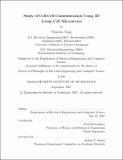Study of cell-cell communication using 3D living cell microarrays
Author(s)
Timp, Winston (Winston G.)
DownloadFull printable version (31.49Mb)
Other Contributors
Massachusetts Institute of Technology. Dept. of Electrical Engineering and Computer Science.
Advisor
Paul Matsudaira.
Terms of use
Metadata
Show full item recordAbstract
Cellular behavior is not dictated solely from within; it is also guided by a myriad of external cues. If cells are removed from their natural environment, apart from the microenvironment and social context they are accustomed to, it is difficult to study their behavior in any meaningful way. To that end, I describe a method for using optical trapping for positioning cells with submicron accuracy in three dimensions, then encapsulating them in hydrogel, in order to mimic the in vivo microenvironment. This process has been carefully optimized for cell viability, checking both prokaryotic and eukaryotic cells for membrane integrity and metabolic activity. To demonstrate the utility of this system, I have looked at a model "quorum sensing" system in Vibrio Fischeri, which operates by the emission and detection of a small chemical signal, an acyl-homoserine lactone. Through synthetic biology, I have engineered plasmids which express "sending" and "receiving" genes. Bacteria containing these plasmids were formed into complex 3D patterns, designed to assay signaling response. The gene expression of the bacteria was tracked over time using fluorescent proteins as reporters. A model for this system was composed using a finite element method to simulate signal transport through the hydrogel, and simple mass-action kinetic equations to simulate the resulting protein expression over time.
Description
Thesis (Ph. D.)--Massachusetts Institute of Technology, Dept. of Electrical Engineering and Computer Science, 2007. This electronic version was submitted by the student author. The certified thesis is available in the Institute Archives and Special Collections. Includes bibliographical references (p. 135-152).
Date issued
2007Department
Massachusetts Institute of Technology. Department of Electrical Engineering and Computer SciencePublisher
Massachusetts Institute of Technology
Keywords
Electrical Engineering and Computer Science.